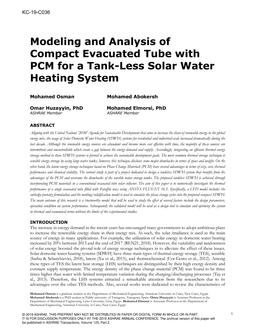Description
Aligning with the United Nations ‘2030’ Agenda for Sustainable Development that aims to increase the share of renewable energy in the global energy mix, the usage of Solar Domestic Water Heating (SDWH) systems for residential and industrial-scale increased dramatically during the last decade. Although the renewable energy sources are abundant and become more cost effective with time, the majority of these sources are intermittent and uncontrollable which create a gap between the energy demand and supply. Accordingly, integrating an efficient thermal energy storage method to these SDWH systems is pivotal to achieve the sustainable development goals. The most common thermal storage technique is sensible energy storage by using large water tanks, however, this technique discloses some major drawbacks in terms of space and weight. On the other hand, the latent energy storage techniques based on Phase Change Materials (PCM) have several advantages in terms of size, cost, thermal performance and chemical stability. The current study is part of a project dedicated to design a tankless SDWH system that benefits from the advantages of the PCM and overcome the drawbacks of the sensible water storage tanks. The proposed tankless SDWH is achieved through incorporating PCM materials in a conventional evacuated tube solar collector. The aim of this paper is to numerically investigate the thermal performance of a single evacuated tube filled with Paraffin wax using ANSYS FLUENT 16.5. Specifically, a CFD model includes the enthalpy-porosity formulation and the melting/solidification model is used to simulate the phase change cycles into the proposed compact SDWH. The main outcome of this research is a trustworthy model that will be used to study the effect of several factors include the design parameters, operation condition on system performance. Subsequently the validated model will be used as a design tool to simulate and optimize the system in thermal and economical terms without the limits of the experimental studies.
Citation: 2019 Annual Conference, Kansas City, MO, Conference Papers
Product Details
- Published:
- 2019
- Number of Pages:
- 8
- Units of Measure:
- Dual
- File Size:
- 1 file , 1.8 MB
- Product Code(s):
- D-KC-19-C036




